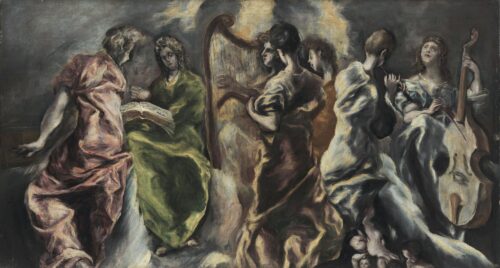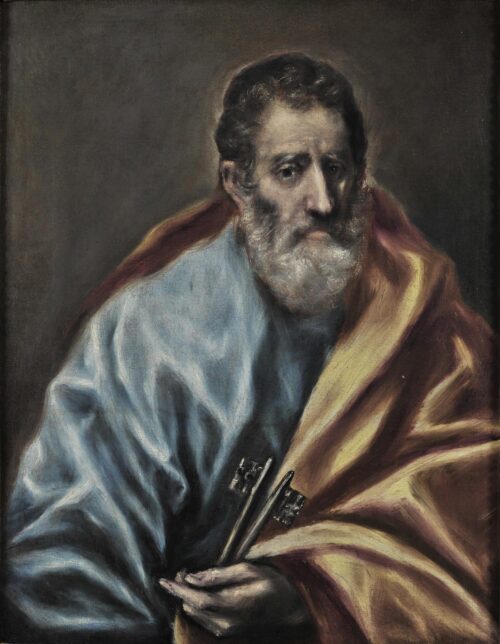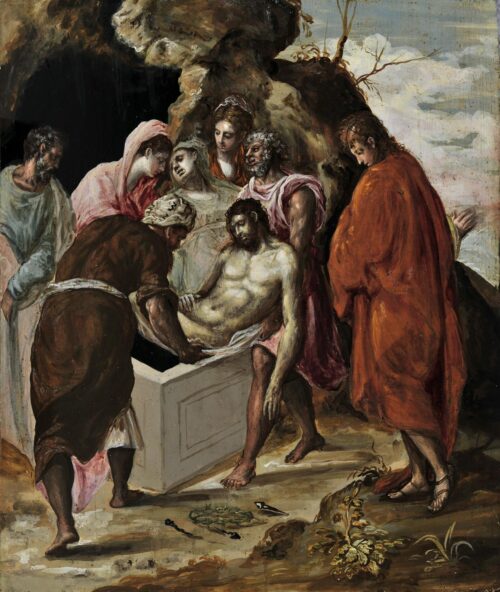
Theotokopoulos Domenicos (1541 - 1614)
The Concert of the Angels, ca 1608-1614
Few elements are known from the painter’s life in Venetian-occupied Chandax, quite an important local art center during the 16th century. His date of birth is taken from his own testimony made during a trial in 1606 when he stated he was at that time sixty five years old; in addition, we know that in 1563 he was already a “master”, that is, an accomplished painter who was professionally exercising his art. From this first period of his artistic creation come the signed icons of the “Evangelist Luke painting the Virgin and Child”, “Adoration of the Magi” (Athens, Benaki Museum) and the “Dormition of the Virgin” (Ermoupolis, Syros, Church of the Dormition of the Virgin), in which the painter’s familiarity with the forms used in both the Orthodox and western tradition can be confirmed.
In 1567 or 1568 he left Crete for Italy where he remained, originally in Venice and later, in 1570, Rome, for about ten years. In Venice he came to know the work of the great teachers of the period, the aged Titian, Tintoretto, and Veronese, while in Rome he was influenced by mannerism. In Italy where he painted works such as the “Triptych of Modena” (Modena, Galleria Estense), “Adoration of the Shepherds” (Frederickssund, Museum J.F. Willumsen) and “View of Mt. Sinae” (Herakleio, Historical Museum), he entered the highest social circles and had the support of powerful patrons of artistic life, such as Cardinal Alessandro Farnese, the miniaturist Giulio Clovio and the librarian Fulvio Orsini, but without being able to secure any truly important commission.
Then he settled in Toledo, Spain, during the reign of Philip II, where he became established as a painter. Portraits and religious works constitute the main body of his Spanish production, among which are most of his masterpieces.During the last twenty-five years of his life in particular (1590-1614), he achieved the acme of his quests and conquests, while late creations such as “Laocoon” (c. 1608-1614, Washington, National Gallery of Art) or “View and Map of Toledo” (c. 1608-1614, Toledo, Greco Museum) are impressive for their iconographic innovations.
He was also a sculptor and architect while compiling theoretical texts on art which unfortunately have been lost.An artist with a humanist education, he produced unique work which is distinguished for its profound spirituality and bears the strong stamp of the intelligence of the creator himself, who is considered to be one of the forerunners of modern European art.

The Concert of the Angels, ca 1608-1614

St. Peter, ca 1600-1607

The Entombment of Christ, ca 1568-1570

We use cookies to make our site work properly, to personalize content and ads, to provide social media features and to analyze our traffic. We also share information about how you use our site with our social media, advertising and analytics partners. Read the Cookies Policy.
These cookies are necessary for the website to function and cannot be switched off in our systems. They are usually only set in response to actions made by you which amount to a request for services, such as setting your privacy preferences, logging in or filling in forms. You can set your browser to block or alert you about these cookies, but some parts of the site will not then work. These cookies do not store any personally identifiable information.
If you disable this cookie, we will not be able to save your preferences. This means that every time you visit this website you will need to enable or disable cookies again.
These cookies tell us about how you use the site and they help us to make it better. For example these cookies count the number of visitors to our website and see how visitors move around when they are using it. This helps us to improve the way our site works, for example, by ensuring that users find what they are looking for easily. Our website uses Google Analytics for statistics reporting.
Please enable Strictly Necessary Cookies first so that we can save your preferences!